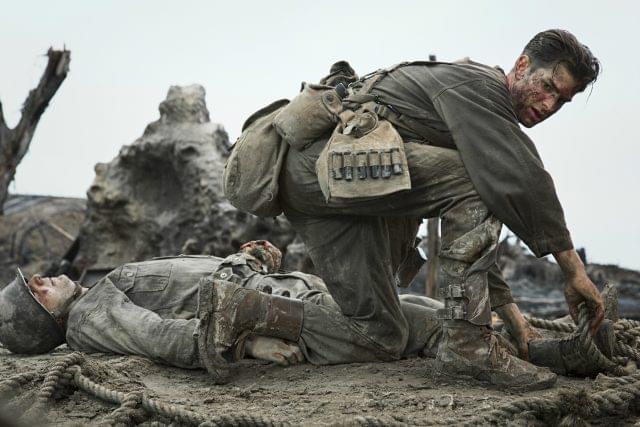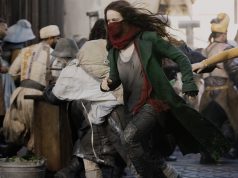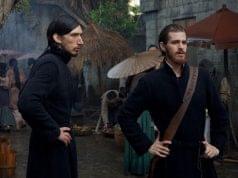
“Hacksaw Ridge” begins with soldiers being set on fire in slow motion while someone recites Bible-y platitudes in a Southern drawl. In other words, it’s a Mel Gibson film, his first opportunity since “Apocalypto,” 10 years ago, to depict stoic men being maimed and killed (which he loves).
It’s a true story — not “based on a true story” or “inspired by a true story,” but, according to the onscreen titles, “A TRUE STORY,” without qualifiers — starring Andrew Garfield as a grinning Virginia hillbilly named Desmond T. Doss who joins the Army in World War II, despite being a pacifist and conscientious objector, to serve as a medic.
The second half of the film, in which Desmond’s principles are put into action on the battlefield, is harrowing and visceral. Much will be made of Gibson’s “Saving Private Ryan”-inspired nightmare of severed limbs and exposed intestines, and those sequences are effectively grotesque. But Gibson also does well with the sweaty, nervous moments in between, with American and Japanese soldiers picking each other off while each side tries frantically to take a hill in Okinawa. Desmond’s heroics here — getting wounded men to safety in the midst of a seemingly unwinnable bloodbath — are stirring, and Garfield’s performance is earnest.
Unfortunately, before you can see the second half of the movie, you have to get through the corny, melodramatic first half. That’s where a young Desmond and his brother (who’s barely seen again) engage in a fistfight that their abusive, drunken father (Hugo Weaving) has no objection to until li’l Desmond picks up a brick and clocks his brother in the head with it. Pointless violence between siblings is fine, but a brick is TOO FAR. Then Dad threatens Desmond with a retaliatory whipping (that’ll show him not to hurt others), but Gibson moves into slow motion again, so it’s Hugo Weaving saying, in a thick, slow, drawl, “Ahhh’m gonnnna haaave to whuuup ya noooooow.” Fortunately, the boys’ mother (Rachel Griffiths) intervenes, and she reminds Desmond that the Lord said thou shalt not kill, nor shalt thou hit thy brother with a brick. Thereafter and forever, Desmond Doss is a pacifist.
Fifteen years later, he enlists in the Army and runs into trouble in basic training, where his drill sergeant (Vince Vaughn) isn’t as sympathetic to his “I refuse to kill anyone” stance as he anticipated. His fellow soldiers, a real who’s who of war movie stereotypes, abuse and taunt him as a coward, trying to make him quit the Army. The movie arbitrarily assigns one, a guy named Smitty (Luke Bracey), as his primary taunter so that there’s someone specific to speak for everyone with an “I misjudged you” speech at the end. Through all the abuse, Desmond remains beatific.
His status as a conscientious objector (he prefers “conscientious supporter”) means he doesn’t have to bear arms, but Desmond won’t even touch a rifle — not for target practice, not to learn how to disassemble and clean it, not for nothin’. This becomes an issue when he has to pass his rifle training in order to advance. While his religious faith seems genuine (he’s Seventh-Day Adventist), this precise refusal to even come into physical contact with a rifle for any reason comes across more persnickety than principled, and court-martialing him over it just prolongs this section of the movie.
But once you get past Hugo Weaving’s unintentionally funny performance and Desmond’s chaste, perfunctory romance with a nurse (Teresa Palmer) and the weirdly cartoonish comedy in the barracks (one guy is always naked; another stabs himself in the foot with a knife) — once you get to the actual war, in other words — the movie becomes respectable, serious, even thoughtful in its treatment of war and conscience. As Desmond scrambles around the battlefield, unarmed, to help injured soldiers, the men come to respect him for doing everything he could to serve without violating his beliefs. Like the heroes in “Braveheart” and “The Passion of the Christ,” Pvt. Desmond T. Doss will not forsake his principles. Unlike them, his steadfastness doesn’t require martyrdom, which makes his example much more appealing to follow.
And since it’s a Mel Gibson movie, there is also a moment where a soldier grabs the top part of a blown-in-half comrade to use as a shield while he runs and fires at the enemy, and you can see the shreds of the dead guy’s guts hanging down.
B- (2 hrs., 11 min.; )





